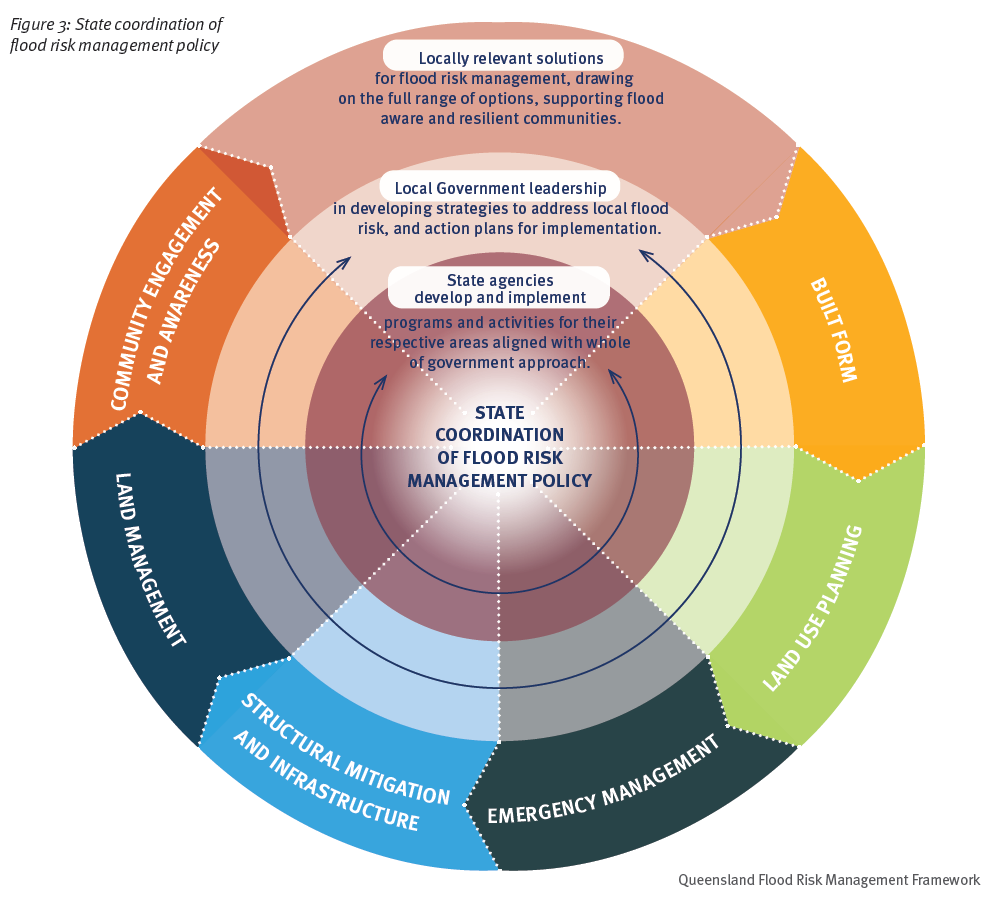Queensland Flood Risk Management Framework
On this page:
Flood Risk Management in Queensland
Flooding causes more damage in Queensland than any other natural hazard, so effective and strategic flood risk management is important for long-term economic, social and environmental sustainability.
Our long-term vision for flood risk management in Queensland is for communities to:
- understand their exposure to flood risk, leading to reduced community impacts of future flood events
- have access to appropriate, timely and accurate warning of impending flood events
- have mitigated any unacceptable risks and have successfully managed the residual risks, now and into the future.
A multi-disciplinary, integrated approach
Our approach to flood risk management is a multi-disciplinary, integrated approach to harness the skills and knowledge of a wide range of stakeholders.
In Queensland, governance of flood risk management is based on a collaborative, decentralised model with shared roles and responsibilities. For the governance model to be successful, the roles and responsibilities of each stakeholder need to be articulated and understood, and stakeholders must be committed to delivering on their responsibilities.
The Queensland Flood Risk Management Framework
The Queensland Flood Risk Management Framework sets the direction for flood risk management statewide, outlines roles and responsibilities, and guides and supports decision-making by councils.
The purpose of the Queensland Flood Risk Management Framework (the Framework) is to:
- set the direction for flood risk management in Queensland
- provide clarity around expectations
- outline the roles and responsibilities of all stakeholders involved
- guide and support decision-making by councils.
The flood risk management process and outcomes can be tailored to apply to the local, regional and state level. This involves steps to:
- collect the necessary data
- define the flood hazard
- assess the risk, and consider options to manage the risk to acceptable levels
- develop an implementation plan to manage the risk.
This staged approach leads to flood risk management outcomes across a range of disciplines, including land use planning, emergency management, community engagement, structural mitigation and infrastructure, land management, built form, and insurance.
The Framework outlines how to build capability and capacity through leadership, governance, accountability and knowledge. It has been informed by the processes of monitoring and review, and communication and consultation, and provides details of the legislative and policy landscape.
Delivery of flood risk management in Queensland
The delivery of flood risk management in Queensland is via a collaborative dispersed model. Roles and responsibilities are dispersed between and across levels of government, along with key actions by industry.
Leadership operates at various levels and functions, including the coordination of strategic policy, implementation and reporting. A clear understanding of how leadership operates is essential for the dispersed model to be effective.
In Queensland, implementation of the dispersed model includes functional areas across and within state agencies and local governments.
State agencies supporting leadership and decision-making responsibilities of local governments are:
- Queensland Reconstruction Authority (QRA)
- Department of Regional Development, Manufacturing and Water (DRDMW)
- Department of State Development, Infrastructure, Local Government and Planning (DSDILGP)
- Queensland Fire and Emergency Services (QFES)
- Department of Environment and Science (DES)
- Department of Energy and Public Works (DEPW)
- Department of Transport and Main Roads (DTMR)
- Department of Seniors, Disability Services and Aboriginal and Torres Strait Islander Partnerships (DSDSATSIP)
Formal collaboration is managed within the Queensland Resilience Coordination Committee (QRCC).
In accordance with the Queensland Reconstruction Authority Act 2011, one of the main functions of QRA is to coordinate the development and implementation of whole-of-government policies for managing flood risks. This sits within QRA’s broader remit to provide for appropriate measures to improve the resilience of communities for potential disasters and mitigate against potential disasters for affected communities.
